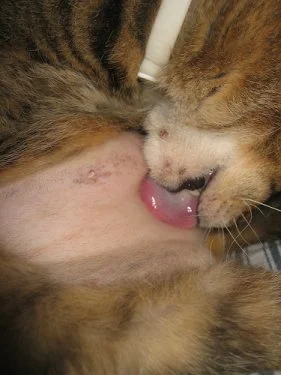
photo by whizchickenonabun (see base of post)
Feline Endocrine Alopecia or balding (alopecia) through a hormonal deficiency is in fact more likely to be hair loss through over grooming.
Feline Endocrine Alopecia falls under the heading of feline hormonal skin disease. Bilateral (both sides of the body) and symmetrical hair loss in animals generally is indicative of a hormonal problem. This methodology is carried forward to the diagnosis of hair loss in cats when in fact the majority of the cases are due to excessive grooming. Three well respected sources concur on this (see sources below).
In some cases particularly neutered tom cats and spayed females of middle age balding may be due to hormonal deficiency. However, treatment with sex hormones is not recommended by Drs Carlson and Giffin (see sources).
Dr Turner and Jean Turner VN say that excessive cat grooming can go unnoticed. However it is possible to tell whether hair loss is due to over grooming or hormonal problems by a microscopic inspection of the hairs in the area of hair loss. I guess this is done with a hand microscope of some sort. When the hairs are broken as opposed to "resting roots" and normal hair tips excessive grooming is indicated.
The technical term for excessive grooming is "Psychogenic Alopecia" or essentially stress related grooming (behavioral problem). Hair loss is usually limited to a symmetrical pattern on the lower abdomen, genital area and perineum (the perineum area in males is between the scrotum and anus and in females between the vulva and anus). The cat is not responding to itching (Drs Carlson and Giffin) in the case of Psychogenic Alopecia.
Psychogenic alopecia may occur more frequently in breeds such as the Siamese, Abyssinian and Burmese. Dr Turner suggests that hormonal treatment may help cats with this condition as it may both stimulate hair growth and calm the cats (and thereby reducing stress induced over zealous grooming). It may help reduce skin irritation as well (if the grooming is caused by skin irritation).
A substantial number if cases of self inflicted hair loss can be attributed to flea allergy and ringworm (Dr. Turner). And an allergic reaction can also be the cause of progressive hair loss on the groin and rear legs (Dr Garvey et al).
Drs Carlson and Giffin say that hormonal skin diseases are uncommon but can be accompanied by a skin infection.
From Feline Endocrine Alopecia to Cat Health Problems
Feline Endocrine Alopecia - Sources:
- http://cancerweb.ncl.ac.uk (definition of perineum)
- The Veterinarians' Guide to Your Cat's Symptoms by Drs Garvey, Hohenhaus, Houpt, Pinckney, Wallace and Elizabeth Randolph
- Veterinary Notes For Cat Owners by Dr Turner and Jean Turner VN
- Cat Owner's Home Veterinary Handbook by Drs Carlson and Giffin
- This is reproduced under a creative commons license = Attribution-NonCommercial-NoDerivs License fully complied with - thanks for the license.
This cat is called Scruggs (I believe) and he/she seems to be grooming excessively the stomach area but looks otherwise healthy (except for a bit of excess weight). Perhaps the photographer who lives with this cat can tell us why his belly is bald.



Hi there,
ReplyDeleteScruggs is indeed the cats name. I'm the guy that lives with him. He's been grooming a lot in the last year or so (he's 13) and causing that little bit of bald on his belly. The vet told me he has some minor skin irritation, but it doesn't really affect his daily routines or his mood. I've just been giving him a little Laxatone to help keep the hairballs to a minimum. Steroids were the other option, but didn't seem worth the money or toll on his body. If the minor itching become something worse, I'll have to look at the problem anew.
Hi, thanks a lot for the comment. It is really nice of you. I chose the photo as a good and interesting illustration but he appears not to have the disease referred to in the post. Thanks again.
ReplyDeleteStimulating the cat with toys, window perches and other accessories to enrich its environment may be helpful in treating the problem, as well as rewarding your cat when it is not pulling its hair out to reinforce that healthy behavior. However, some cats may need sedatives and mood-elevators to resolve the problem.
ReplyDeleteYes, thanks for the comment. Good sense.
ReplyDelete